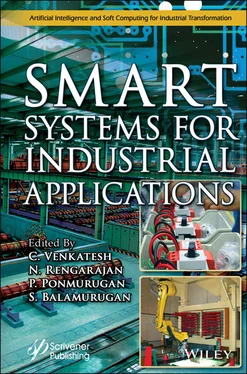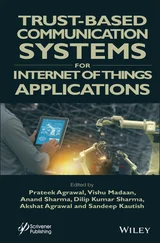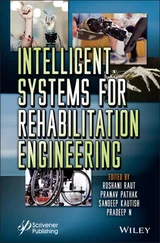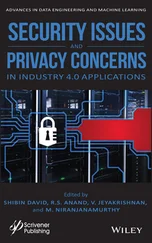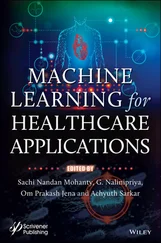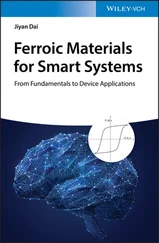Smart Systems for Industrial Applications
Здесь есть возможность читать онлайн «Smart Systems for Industrial Applications» — ознакомительный отрывок электронной книги совершенно бесплатно, а после прочтения отрывка купить полную версию. В некоторых случаях можно слушать аудио, скачать через торрент в формате fb2 и присутствует краткое содержание. Жанр: unrecognised, на английском языке. Описание произведения, (предисловие) а так же отзывы посетителей доступны на портале библиотеки ЛибКат.
- Название:Smart Systems for Industrial Applications
- Автор:
- Жанр:
- Год:неизвестен
- ISBN:нет данных
- Рейтинг книги:3 / 5. Голосов: 1
-
Избранное:Добавить в избранное
- Отзывы:
-
Ваша оценка:
- 60
- 1
- 2
- 3
- 4
- 5
Smart Systems for Industrial Applications: краткое содержание, описание и аннотация
Предлагаем к чтению аннотацию, описание, краткое содержание или предисловие (зависит от того, что написал сам автор книги «Smart Systems for Industrial Applications»). Если вы не нашли необходимую информацию о книге — напишите в комментариях, мы постараемся отыскать её.
The prime objective of this book is to provide an insight into the role and advancements of artificial intelligence in electrical systems and future challenges.
Audience
Smart Systems for Industrial Applications — читать онлайн ознакомительный отрывок
Ниже представлен текст книги, разбитый по страницам. Система сохранения места последней прочитанной страницы, позволяет с удобством читать онлайн бесплатно книгу «Smart Systems for Industrial Applications», без необходимости каждый раз заново искать на чём Вы остановились. Поставьте закладку, и сможете в любой момент перейти на страницу, на которой закончили чтение.
Интервал:
Закладка:
In [29], the authors present SAB-UAS using a smart card with three entities in the healthcare communication chain, medical practitioners, wireless gateways, and wearable sensors. Moment SAB-UAS scheme starts process, two master keys are generated along with a long-term secret key by Wireless gateways, which is then transmitted to wearable sensors. Gateways quickly try to use one of the master keys, establishing it as a public key. This system is simulated at three stages, mainly user name registration, system login and authentication, and any case of revocations. After simulating SAB-UAS at three stages, the formal security analysis is also simulated. Random Oracle model is used to prove the security efficiency of SAB-UAS. The simulation clearly shows SAB-UAS scheme can securely protect sensitive information from various retrieval mechanisms. An informal security attack is also simulated with different 12 independent conditions, and it can meet the security goals setup. It is essential to understand whether SAB-UAS is also efficient because the electronic healthcare system comprises lightweight resources with very many limitations like storage capacity, bandwidth, and processing capabilities. Resource efficiency analysis is computed to understand storage, communication, and computation capabilities observed under the following conditions:
1 (i) Analysis of Packet Delivery Ratio (PDR): With a large number of sensors, efficiency in a PDR of SAB-UAS deteriorates.
2 (ii) Analysis of End-to-End (ETE) delay: There is a lesser delay compared to other methods. But with the increasing number of communication nodes, the delay in ETE is proportional.
3 (iii) Analysis of Throughput Transmission Rate (TTE): SABUAS has a better throughput rate compared to other authentication systems, and there are negligible deviations in TTE even when there were increased communication nodes.
4 (iv) Analysis of Routing Overhead (RTO): SAB-UAS seems to have tactful management of packet routing enhancing network performance and bandwidth usage.
The above simulations are essential in an environment of Remote Healthcare because the speed and efficiency of resources play a critical role in patient health. Response time should not be lost at the cost of security as well. SAB-UAS performs well compared to other authentication systems. Maybe with increasing communication nodes, it has lower efficiency in PDR and ETE. This proposed SAB-UAS scheme can substantially improve performance at the storage, computation, and communication level at the same time, keeping costs at lower. This, in turn, makes Remote Healthcare Management a real-time application. SAB-UAS has robust security when it comes to both formal and informal security threats and potential attacks. The essential of IoT and security of collected information are summarized in Table 1.5.
1.6 AI-Driven Augmented and Virtual Reality–Based Communication Technologies and Healthcare Applications
Technology is getting better, smaller, and faster. Virtual reality (VR) is a highly interactive, computer-based multimedia environment in which the user becomes the participant in a computer-generated world. VR and augmented reality (AR) are having an impact on most aspects of modern life. AR is an integration of the real world and the virtual world, with the aim of providing additional information about something in the real world with information displayed in the virtual world. In recent times, the scope of AR applications has expanded to include innovation for the domains of Research, Science, Medicine, Telecommunications, etc. For instance, a person could look at a painting or a machine in the real world, hold up their smartphones or tablet in front of the painting or machine, and see on the screen the painting or machine with additional useful information, thus augmenting reality. It is becoming ever more in demand in every segment of the economy, particularly in healthcare. With the technological advancements in AI, their demand is also increasing progressively in healthcare applications. Not just in healthcare, VR is helping organizations in different sectors to train their workforce as a good communicator. In reference to Healthcare and Medical Clinics, simulations are developed with a pre-defined script and one or more avatars with whom the player can interact. This article describes the impact of VR and AR in communication technologies and healthcare applications.
Table 1.5 Role of AI-driven IoT in healthcare services.
| Source | Subject matter | Applications | Related performance measures |
| [26] | Digital transformation | Automated management and monitoring chronic conditions | Sensor devices usage increases up to 23.8% Compound Annual Growth Rate (CAGR) |
| [27] | Hierarchical computing Architecture for Healthcare IoT | Machine learning–based data analyticsClosed-loop autonomous system | Employed in arrhythmia detection for patients suffering from cardiovascular diseasesAchieves 93.6 accuracy using k-fold cross validation method. |
| [28] | Regulation of wireless devices operation | Dynamic and interoperable communication framework | Enhances the decision-making capabilities of wearable sensors.Optimizes device lifetime, storage capacity and handling multiple communication channel |
| [29] | Security parameters | Secure-Anonymous Biometric-based User Authentication Scheme (SAB-UAS) | Achieves delay up to 0.02 seconds in a network with 160 sensor nodes.Also achieves throughput of 2500bps with a same network |
1.6.1 Clinical Applications of Communication-Based AI and Augmented Reality
AI, together with AR, has vast clinical and surgical applications in healthcare. The unsupervised models allow the system to recognize the patterns followed by the initiation of the algorithm based on previous patterns. In addition, reinforcement learning algorithms use positive and negative rewards or punishments in their learning methodologies [30]. Whether the relationship between input and output is linear or not, the programs go through more decision-making layers to deduce a mathematical rule to create outputs based on specific inputs. The disciplines of medicine that rely on deep learning that include radiology and pattern recognition have become more precise than human intervention methods [31]. Deep learning algorithms are applied in finding out malignancy and improving neonatal imaging and neurologic imaging qualities.
The AI models are used to forecast the readmission and delayed discharge [32]. There are various lung cancer models used to aid in the prediction, diagnosis, and planning of treatments [33]. The prediction of survival rate after surgery is modeled for cervical cancer patients [34]. From applications like simple prognostic tools to big and complex models, AI is used. There is also a saying that AI models are superior to traditional regression models for outcome prediction [34]. All the way, virtual AI is yet to reach its high potential in gynecology. There are various opportunities that exist to improve the treatment and diagnosis, especially in gynecologic oncology.
1.6.2 Surgical Applications of Communication-Based on Artificial Intelligence and Augmented Reality
There are developments in the new paradigm that enhance human abilities more than AI to support, along with decision-making and surgery. The development of AI-based AR communication systems can reduce natural limitations, improve awareness so that it can minimize error, and improve the efficiency of movement. The AR-based AI communication has already proved to reduce surgery time and they verify the improved accuracy [35]. The communication assisted AR is applied in gynecologic surgery in the way of robotic tools to overcome the drawback in surgical skills. The communication-based and robotic-assisted tools reduce the human tremor so that the accuracy can be maximized.
Читать дальшеИнтервал:
Закладка:
Похожие книги на «Smart Systems for Industrial Applications»
Представляем Вашему вниманию похожие книги на «Smart Systems for Industrial Applications» списком для выбора. Мы отобрали схожую по названию и смыслу литературу в надежде предоставить читателям больше вариантов отыскать новые, интересные, ещё непрочитанные произведения.
Обсуждение, отзывы о книге «Smart Systems for Industrial Applications» и просто собственные мнения читателей. Оставьте ваши комментарии, напишите, что Вы думаете о произведении, его смысле или главных героях. Укажите что конкретно понравилось, а что нет, и почему Вы так считаете.
